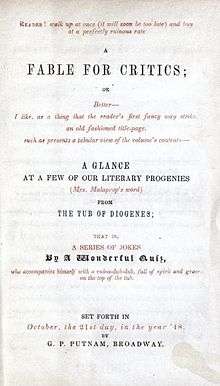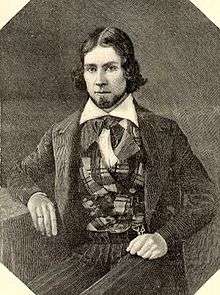A Fable for Critics

A Fable for Critics is a book-length poem by American writer James Russell Lowell, first published anonymously in 1848. The poem made fun of well-known poets and critics of the time and brought notoriety to its author.
Overview
A Fable for Critics satirized many of the most important figures in American literature at the time, including Ralph Waldo Emerson and James Fenimore Cooper.[1] Many of his harshest judgments were aimed at names that have not survived in posterity, including Nathaniel Parker Willis, Cornelius Mathews, and Fitz-Greene Halleck.[2] He gave ample praise to Charles Frederick Briggs and Lydia Maria Child, though he was friends with both and likely allowed his friendship to inflate his assessment of their talents.[3] Of Edgar Allan Poe, he said he was "three-fifths genius... and two-fifths sheer fudge".[1] Lowell included himself as well, referring to himself as having difficulty determining the difference "'twixt singing and preaching".[4] Many of the poetic portraits were balanced with praise, as in Halleck's:
Halleck's better, I doubt not, than all he has written;
In his verse a clear glimpse you will frequently find
If not of a great, of a fortunate mind[5]
Lowell's most vicious treatment was aimed at Margaret Fuller, whom he referred to as Miranda.[6] At first, he intended to exclude her entirely but thought it more insulting not to include her[7] and was convinced to write "a line or two" by his wife Maria White Lowell.[8] Ultimately, his characterization was the only which was wholly negative and not balanced with praise.[8] He suggested that she stole old ideas and presented them as her own and that she was only genuine in her spite.[9]
Publication history

A Fable for Critics, with the subtitle "A Glance at a Few of Our Literary Progenies", was published anonymously as a pamphlet early in 1848.[2] Three thousand copies were sold in short order.[10] Lowell had hoped there would be sufficient profit from his sales, which he intended to turn over to his financially struggling friend Briggs, though it was said the profit was only enough to purchase one small silver plate.[10] The poem was reprinted several times with Lowell's name after its initial publication. One version included an introductory note explaining its author's intentions: "This jeu d'esprit was extemporized, I may fairly say, so rapidly was it written, purely for my own amusement and with no thought of publication" until convinced to do so by Briggs.[2]
Critical response
John Ruskin labeled the poem "in animal spirit and power... almost beyond anything I know".[6] Oliver Wendell Holmes found it "capital—crammed full and rammed down hard—with powder (lots of it)—shot—slugs—very little wadding... all crowded into a rusty-looking sort of blunderbuss barrel, as it were—capped with a percussion preface—and cocked with a title page as apropos as a wink to a joke".[6] Henry Wadsworth Longfellow compared it to Lord Byron's "English Bards" as being "full of wild wit and deviltry, and amazingly clever".[10] Freeman Hunt reviewed the poem for Merchants' Magazine in December 1848 and remarked on how true the character assessments were: "Our friends Bryant, Halleck, Willis, Whittier, Poe, and last but not least, Harry Franco, (Briggs,) are, in our judgment, as genuine life pictures as were ever sketched with pen or pencil, in prose or verse. The severity, if any, is lost in the general fidelity of the delineations."[11]
Lowell's friends objected to the intense criticism of Fuller, specifically William Wetmore Story [6] and Thomas Wentworth Higginson.[9] Edgar Allan Poe reviewed the work in the Southern Literary Messenger and called it "'loose'—ill-conceived and feebly executed, as well in detail as in general... we confess some surprise at his putting forth so unpolished a performance".[12] His final judgment was that the work was not successful: "no failure was ever more complete or more pitiable".[13] Ultimately, A Fable for Critics earned Lowell notoriety as a poet, once his name was revealed,[1] though he did not significantly profit from its publication.[10]
Notes
- 1 2 3 Sullivan, 214
- 1 2 3 Heyman, 81
- ↑ Duberman, 98
- ↑ Sullivan, 214–215
- ↑ Duberman, 97
- 1 2 3 4 Heymann, 83
- ↑ Von Mehren, Joan. Minerva and the Muse: A Life of Margaret Fuller. Amherst: University of Massachusetts Press, 1994: 294. ISBN 1-55849-015-9
- 1 2 Duberman, 99
- 1 2 Duberman, 100
- 1 2 3 4 Duberman, 101
- ↑ Thomas, Dwight and David K. Jackson. The Poe Log: A Documentary Life of Edgar Allan Poe 1809–1849. New York: G. K. Hall & Co., 1987: 774. ISBN 0-7838-1401-1
- ↑ Sova, Dawn B. Edgar Allan Poe: A to Z. New York: Checkmark Books, 2001: 141–142. ISBN 0-8160-4161-X.
- ↑ Silverman, Kenneth. Edgar A. Poe: Mournful and Never-ending Remembrance. New York: Harper Perennial, 1991: 405. ISBN 0-06-092331-8.
References
- Duberman, Martin. James Russell Lowell. Boston: Houghton Mifflin Company, 1966.
- Heymann, C. David. American Aristocracy: The Lives and Times of James Russell, Amy, and Robert Lowell. New York: Dodd, Mead & Company, 1980. ISBN 0-396-07608-4
- Sullivan, Wilson. New England Men of Letters. New York: The Macmillan Company, 1972. ISBN 0-02-788680-8
External links
| Wikisource has original text related to this article: |
- A Fable for Critics – 1856 edition from Google Book Search
- Review of A Fable for Critics by Edgar Allan Poe at the Edgar Allan Poe Society